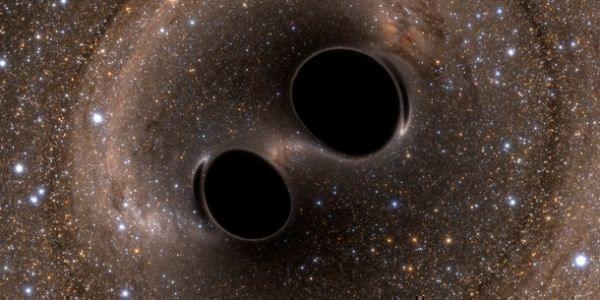U of I Researchers Included In Gravitational Wave Discovery

This image of binary black holes about to collide, forming a single black hole, is from an animation provided by LIGO, depicting the phenomenon that caused the gravitational waves 1.3 billion years ago, and picked up by LIGO detectors last September. LIGO
They were predicted by Einstein’s Theory of General Relativity a century ago. Now, researchers say they’ve detected gravitational waves --- ripples in space-time --- for the first time. The discovery was made by the LIGO (Laser Interferometer Gravitational-wave Observatory) project, the collaborative effort of many colleges and universities, including the University of Illinois.
U of I astrophysicist Eliu Huerta is a member of the LIGO collaboration, and co-author of a paper on its observance of gravigational waves, accepted for publication in the journal Physical Review Letters.
Led by researchers at MIT and CalTech and funded by the National Science Foundation, LIGO built massive detectors in Louisiana and Washington State using Lasers emitting beams for 2 and a half miles. First constructed in 2002, the LIGO detectors underwent a major upgrade in 2014. The upgrade is credited for the first confirmation of gravitational waves last September, caused by the collision of two black holes 1.3 billion light years away.
Huerta says the discovery shows Einstein was right, and opens up a new field of gravitational wave astronomy.
“You can rightly say that this discovery is on par with the discovery of the Higgs boson and maybe the moon landing,” said Huerta, “because all the science that came from that changed the way we understand the cosmos. And that is exactly what is going to happen from now on.”
Huerta says the discovery also provides new evidence of black holes, which he says the U of I’s National Center for Supercomputing Applications has been studying through the construction of computer models for years.
U of I astrophysicist Stuart Shapiro is one of the researchers working on computer models of black holes at the NCSA. From his initial look at the LIGO study, he says the gravitational wave data looks to be a very close match to the models of binary black hole collisions that he’s worked on.
“They seem to be in incredible agreement, at the level of precision that they’re capable of, but within that level, incredible agreement with our theoretical understanding,” said Shapiro. “It’s almost too good to be true, but it is true.”
Shapiro says he looks forward to more gravitational wave data providing evidence of other massive astronomical events, such as collisions involving neutron stars (compact stars formed from the gravitational collapse of a massive start after a supernova), or black holes and neutron stars together.
Links
- National Center for Supercomputing Applications Turns 25
- IBM Returns Money for Supercomputer Project
- IBM Withdraws from Blue Waters Supercomputer Project
- About NCSA’s Blue Waters Super Computer
- Blue Waters Supercomputer Officially Launched
- New Fastest Supercomputer Will Be Outpaced by Blue Waters, Says U of I
- LIGO news release on gravitational wave observance
- NSCA news release on gravitational wave observance

